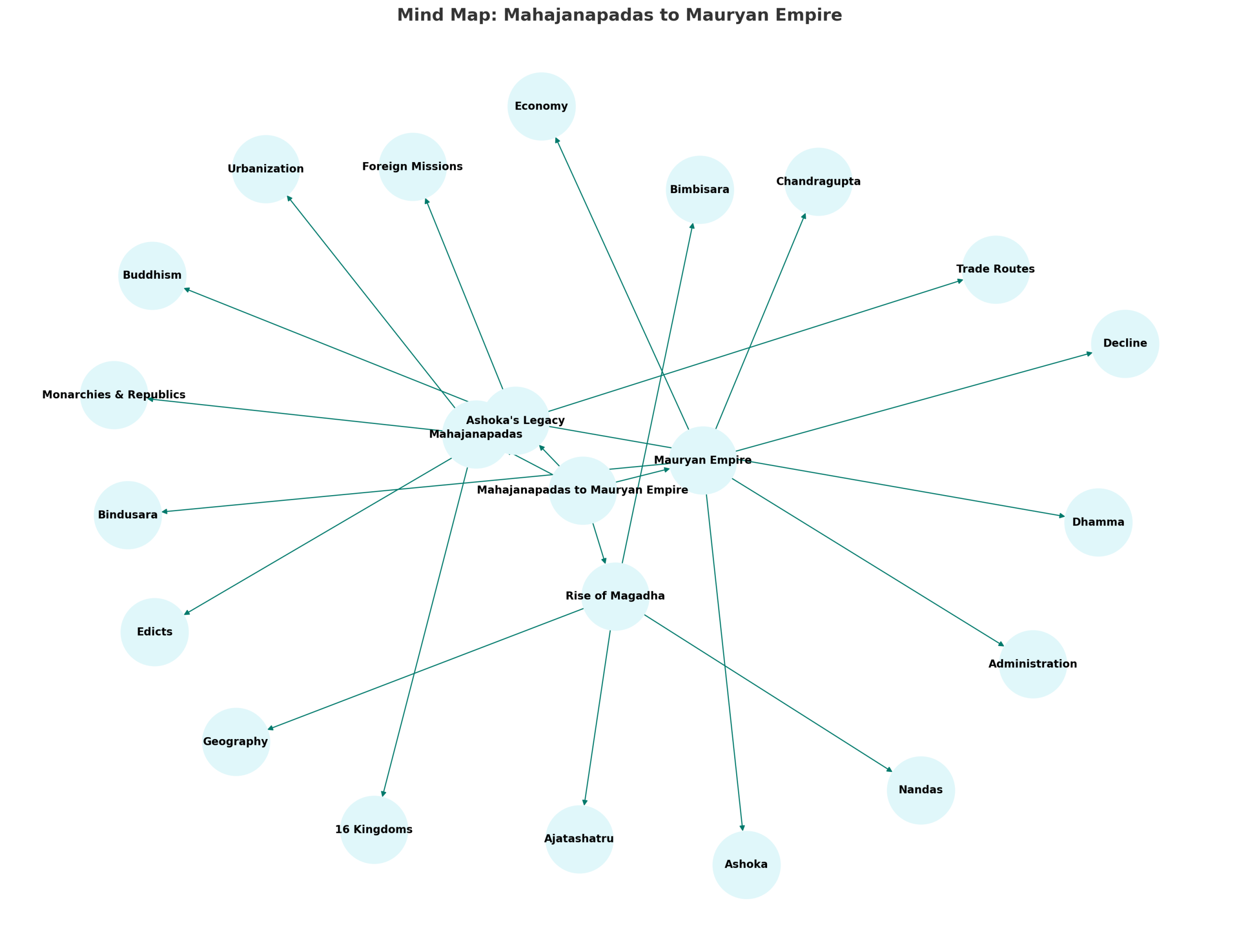
22 Jul Mahajanapadas to Mauryan Empire
Mahajanapadas to Mauryan Empire – UPSC History Optional Paper 1
Introduction
The period between the emergence of Mahajanapadas and the rise and fall of the Mauryan Empire (6th century BCE to 2nd century BCE) marks a turning point in ancient Indian history. This era witnessed the consolidation of states, the emergence of imperial authority, and profound transformations in administration, economy, religion, and diplomacy. For UPSC aspirants, this topic is vital for Paper 1 of the History Optional syllabus and frequently features in the examination through both direct and analytical questions.
1. Mahajanapadas (c. 600 BCE)
By the 6th century BCE, the Indian subcontinent saw the emergence of territorial states called Mahajanapadas. These replaced earlier tribal units and marked the beginning of early state formation in ancient India.
1.1 Sixteen Mahajanapadas
- Key Mahajanapadas: Magadha, Kosala, Avanti, Vatsa, Kuru, Panchala, Matsya, Surasena, Chedi, Malla, Vajji, Kamboja, Gandhara, Assaka, Anga, and Kasi
- Sources: Anguttara Nikaya (Buddhist text), Jain literature, and Panini’s Ashtadhyayi
1.2 Monarchical vs. Republican States
- Monarchies: Magadha, Kosala, Vatsa, Avanti
- Republics (Gana-Sanghas): Vajji, Malla, Kamboja – ruled by assemblies
1.3 Economic and Political Developments
- Urbanization and second urbanization (e.g., Rajagriha, Kaushambi)
- Use of iron tools and plough for agriculture
- Rise of coinage: Punch-marked coins
- Strategic location on trade routes like Uttarapatha and Dakshinapatha
-
Best history optional coaching in delhi
best history optional test series
2. Rise of Magadha
Among the sixteen Mahajanapadas, Magadha emerged as the most powerful, eventually laying the foundation of the Mauryan Empire.
2.1 Geographic Advantage
- Fertile Gangetic plains
- Rich iron ore deposits (Chotanagpur Plateau)
- Control of strategic trade routes
2.2 Dynastic Succession
- Haryanka Dynasty: Bimbisara (used diplomacy, matrimonial alliances), Ajatashatru (wars with Kosala, Vajji; fortified Rajagriha)
- Shishunaga Dynasty: Shifted capital to Vaishali and then back to Pataliputra
- Nanda Dynasty: Mahapadma Nanda expanded the empire; strong centralized army and revenue system
3. Mauryan Empire (322–185 BCE)
The Mauryan Empire was the first political entity to unify most of the Indian subcontinent under a single administration. It set the precedent for future imperial systems in India.
3.1 Chandragupta Maurya (322–297 BCE)
- Founded the empire with the help of Kautilya (Chanakya)
- Overthrew the Nandas and defeated Seleucus I (Greek general of Alexander)
- Marriage alliance with Seleucus, received territories like Kabul and Kandahar
- Capital: Pataliputra
- Converted to Jainism and abdicated the throne (died at Shravanabelagola)
3.2 Bindusara (297–273 BCE)
- Extended the empire southward up to Karnataka (excluding Tamil kingdoms)
- Maintained diplomatic relations with Hellenistic kings (e.g., Antiochus I)
3.3 Ashoka the Great (273–232 BCE)
- Fought the Kalinga War (c. 261 BCE), resulting in massive bloodshed
- Embraced Buddhism and propagated Dhamma (moral code)
- Issued Rock and Pillar Edicts throughout the empire
- Sent Buddhist missions to Sri Lanka, Southeast Asia, Central Asia
3.4 Administration
- Centralized bureaucracy with departments and spies (as per Arthashastra)
- Provincial rule by Kumara (royal princes)
- Revenue collection from land, trade, forests, and mines
- Army: Infantry, cavalry, elephants, chariots; supervised by specialized officers
3.5 Economy and Society
- State control over agriculture, industries, and trade
- Use of standardized weights and measures
- Emergence of professional administrators and scribes
3.6 Decline of the Mauryan Empire
- Weak successors after Ashoka
- Economic strain due to extensive welfare and military expenditure
- Territorial decentralization and rise of local powers
- Empire ended with the assassination of Brihadratha by Pushyamitra Shunga (185 BCE)
4. Legacy of the Mauryan Empire
- First large-scale empire in Indian history
- Model for administrative practices for later dynasties
- Promotion of Buddhism as a world religion
- Architectural and archaeological evidence (Stupas, Pillars, Edicts)
Previous Year Questions – UPSC History Optional
- 2022: Discuss the features of administration under Ashoka as gleaned from his Edicts.
- 2020: Evaluate the factors responsible for the rise of Magadha among the Mahajanapadas.
- 2018: What role did the Mauryan state play in controlling trade and economy?
- 2016: Examine the relationship between political expansion and religious movements in Mauryan India.
Probable Questions for UPSC Mains 2025
- Compare the administration of Magadhan kingdoms with that of the Mauryan Empire.
- Critically assess the role of geography in the emergence of Magadha as a powerful Mahajanapada.
- Discuss Ashoka’s concept of Dhamma in the context of polity and society.
- Evaluate the economic foundations of Mauryan imperialism.
Download Visual Aids
Conclusion
The transition from Mahajanapadas to the Mauryan Empire reflects the complex political, economic, and ideological transformation in ancient India. The Mauryan Empire, especially under Ashoka, laid the foundation for a centralized state, widespread cultural integration, and the promotion of a moral governance model. For UPSC aspirants, understanding this transformative period is essential to grasp the early trajectory of Indian polity and society.




No Comments